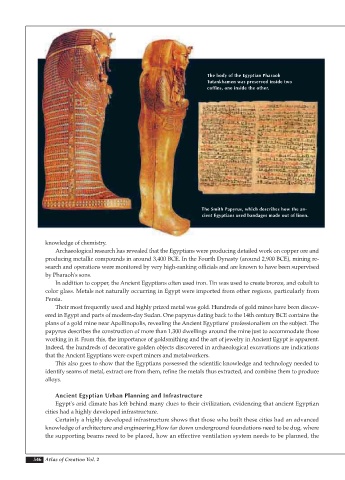Page 548 - Atlas of Creation Volume 2
P. 548
The body of the Egyptian Pharaoh
Tutankhamen was preserved inside two
coffins, one inside the other.
The Smith Papyrus, which describes how the an-
cient Egyptians used bandages made out of linen.
knowledge of chemistry.
Archaeological research has revealed that the Egyptians were producing detailed work on copper ore and
producing metallic compounds in around 3,400 BCE. In the Fourth Dynasty (around 2,900 BCE), mining re-
search and operations were monitored by very high-ranking officials and are known to have been supervised
by Pharaoh's sons.
In addition to copper, the Ancient Egyptians often used iron. Tin was used to create bronze, and cobalt to
color glass. Metals not naturally occurring in Egypt were imported from other regions, particularly from
Persia.
Their most frequently used and highly prized metal was gold. Hundreds of gold mines have been discov-
ered in Egypt and parts of modern-day Sudan. One papyrus dating back to the 14th century BCE contains the
plans of a gold mine near Apollinopolis, revealing the Ancient Egyptians' professionalism on the subject. The
papyrus describes the construction of more than 1,300 dwellings around the mine just to accommodate those
working in it. From this, the importance of goldsmithing and the art of jewelry in Ancient Egypt is apparent.
Indeed, the hundreds of decorative golden objects discovered in archaeological excavations are indications
that the Ancient Egyptians were expert miners and metalworkers.
This also goes to show that the Egyptians possessed the scientific knowledge and technology needed to
identify seams of metal, extract ore from them, refine the metals thus extracted, and combine them to produce
alloys.
Ancient Egyptian Urban Planning and Infrastructure
Egypt's arid climate has left behind many clues to their civilization, evidencing that ancient Egyptian
cities had a highly developed infrastructure.
Certainly a highly developed infrastructure shows that those who built these cities had an advanced
knowledge of architecture and engineering.How far down underground foundations need to be dug, where
the supporting beams need to be placed, how an effective ventilation system needs to be planned, the
546 Atlas of Creation Vol. 2

